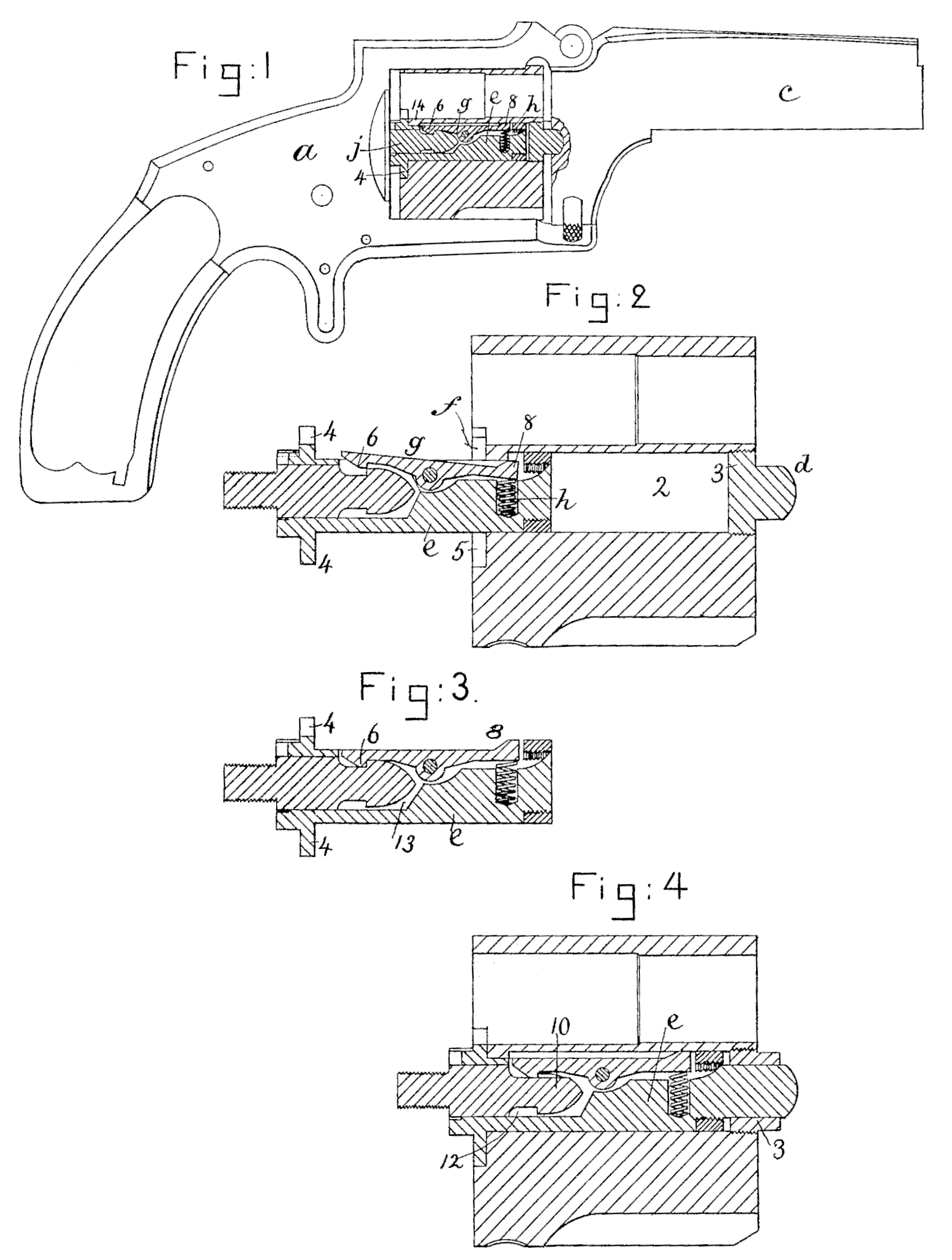US 222066
UNITED STATES PATENT OFFICE.
JOHN M. MARLIN, OF NEW HAVEN, CONNECTICUT,
IMPROVEMENT IN REVOLVING FIRE-ARMS.
Specification forming part of Letters Patent No. 222,066, dated November 25, 1879; application filed July 15, 1879.
To all whom it may concern:
Be it known that I, John M. Marlin, of New Haven, county of New Haven, State of Connecticut, have invented an Improvement in Extractors for Revolving Fire-Arms, of which the following description, in connection with the accompanying drawings, is a specification.
This invention relates to extractors for revolving fire-arms.
In this invention the extractor is composed of a plug provided with shell-extracting projections, the plug entering the opening at the axial center of the cylinder. The plug has one or more pivoted latches, which serve at the proper times to engage the plug with the head of a fixed stud, or to disengage it there from preparatory to reloading the cylinder.
Figure 1 represents, in side elevation, a revolver provided with my improvement, the cylinder, extractor, and stud being shown in longitudinal section. Fig. 2 shows a similar section of the cylinder, extractor, and stud alone, the cylinder having been almost with drawn from the stud. Fig. 3 represents the extractor in section, and Fig. 4 is a modification of the invention.
The frame or handle part a, barrel part c of the revolver, the cylinder, and means to revolve it may be all of usual construction.
The forward end of the central opening, 2, of the cylinder has fitted to it a block, 3, with a projecting bearing-piece, d; but instead of being solid, as in Fig. 2, the said piece may be hollow, as in Fig. 4.
The extractor is composed of a plug, e, made hollow through part of its length, and provided with cartridge-engaging projections 4, which, when the extractor is within the cylinder, as in Figs. 1 and 4, enter recesses fat the rear of the cylinder. When the cartridges are in the cylinder the said projections are covered by the cartridge rims or flanges.
The extractor has pivoted upon it a latch, g, provided at its outer end with a hook, 6, to engage a head-piece, 10, formed by making an annular groove, 12, in a stud, j, screwed into the frame part a, or into the face of the breech. The opposite or forward end of the latch has an incline, 8, and the latch is operated upon by a spring, h, which permits the said latch to turn as the head 10 is passed under it into the opening 13 of the extractor, the said spring acting to keep the hook 6 in engagement with the groove 12 at the rear of the head 10 until such time as the part 14 of the cylinder, as it is being withdrawn from the extractor, meets the incline 8 of the latch, when the latter, acted upon by the projecting part or shoulder 14, is turned as shown in Fig. 2, causing the hook 6 to be released from the stud, after which the extractor and cylinder may be removed from the said stud and the extractor be again pushed into the cylinder, when the latter may be again loaded and be replaced upon the stud, as in Fig. 1.
In Fig. 4 the front end of the extractor is extended through the block 3.
If desired, the extractor may be provided with more than one latch.
I claim—
1. The extractor composed of a plug and projections 4, combined with a latch pivoted thereon, and adapted to engage the head of a stud attached to the frame or breech part, substantially as described.
2. The extractor, the latch pivoted thereon, provided with a hook, 6, an incline, 8, and a spring to turn the latch in one direction, combined with the cylinder and its projection 14, to operate upon the incline and turn the latch to disengage it from the stud, substantially as described.
In testimony whereof I have signed my name to this specification in the presence of two subscribing witnesses.
JOHN M. MARLIN.
Witnesses:
James Reynolds,
Wm. E. Ward.

